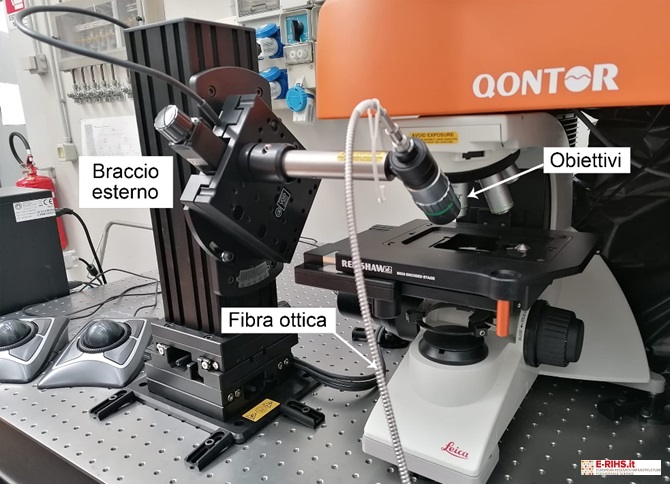
LABORATORY: CNR-ISPC
NAME OF THE INSTRUMENT
Micro-Raman (Renishaw inVia Qontor)
GENERAL DESCRIPTION
In Cultural Heritage field, Raman spectroscopy is one of techniques of choice for the identification of pigments (both inorganic and organic) used in paintings, frescos, and decorated objects. The advantage of this technique is its high chemical selectivity which leads to the ability to unequivocally identify the type of molecules, and consequently, the type of pigments. Raman data allows reconstructing the artist’s technique, as well as the artwork state of conservation. In fact, in addition to the palette, information about the presence of degradation products or substances used for conservation purposes can be achieved.
The instrument is a micro-Raman system, which is a Raman spectrometer coupled with an optical microscope. This setup enables high lateral resolution analyses (less than 1 µm), ideal for characterizing heterogeneous materials at the micrometric scale like those encountered in Cultural Heritage field. Both point measurements and two-dimensional mapping can be performed, providing information about the distribution of different compounds on the surface of the objects.
To explore the internal portions non-invasively, a method has been developed—micro-Spatially Offset Raman Spectroscopy (micro-SORS)—able to detect the molecular composition of compounds located below the surface, within the microscale resolution.
The instrument is optimized for micro-SORS measurements, consisting of the acquisition of Raman spectra at selected distances (offsets) from the laser incidence point.In this way, the detection of Raman photons generated deeper within the sample and emerging laterally at the surface is achieved.The interpretation of micro-SORS spectra, for instance, enables the reconstruction of the painted layer sequence or the identification of degradation products beneath the surface.
TECHNICAL DESCRIPTION
The instrument is a Renishaw inVia Qontor micro-Raman system, equipped with a Peltier cooled (-70C) NIR enhanced CCD camera, a Leica DM2700 microscope, a 785 nm excitation laser and a spectral resolution of 1-2 cm-1Conventional Raman spectra can be collected using 5x, 20x, 50x and 100x microscope objectives by focusing the laser at the surface of the sample. The lateral resolution with 100x microscope objective is less than 1µm.
Micro-SORS measurements with defocusing variant are acquired at progressively increased distances (∆z) between the sample and the microscope objective using a motorized micro-stage controlled by the instrument software (WiRE).
The external arm, which allows measurements with full micro-SORS, SORS variant, is mounted on a micrometric stage to set lateral offsets (∆x) with high accuracy and reproducibility. The laser is focused on the sample through a SLWD 20X objective (WD 30.5 mm) at approximately 38 with respect to the normal to the incidence plane. The collection of Raman photons is provided by a LWD 20X objective (WD 6.9 mm)
Referent:
Claudia Conti claudia.conti@cnr.it
